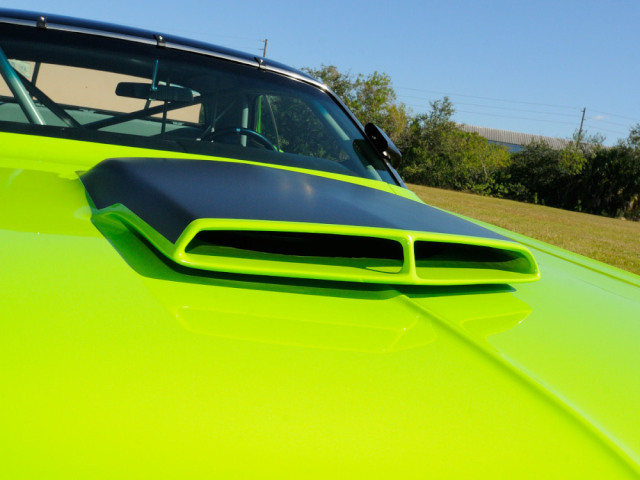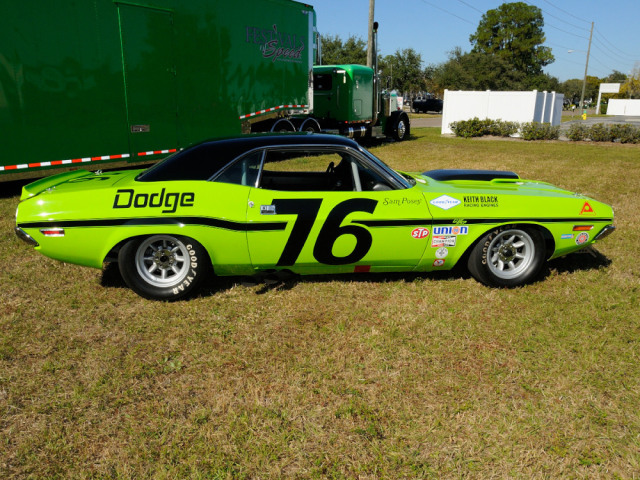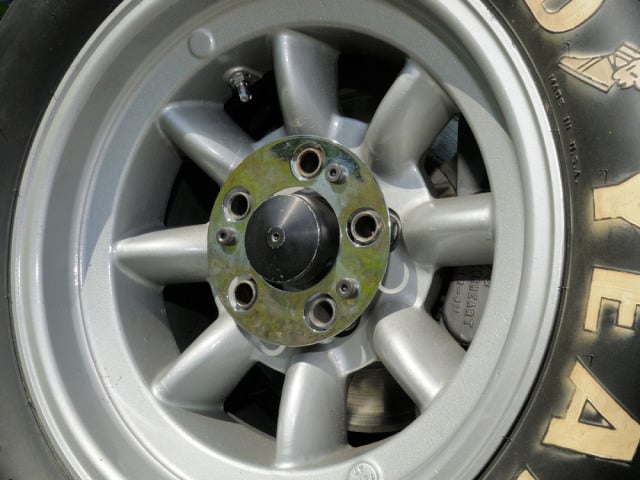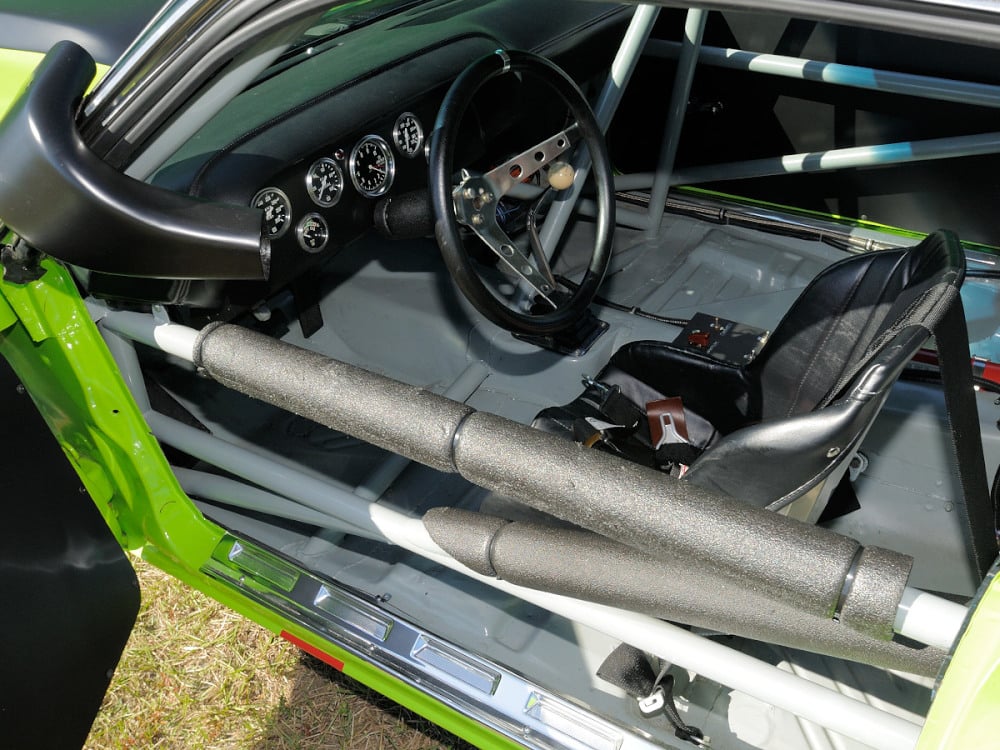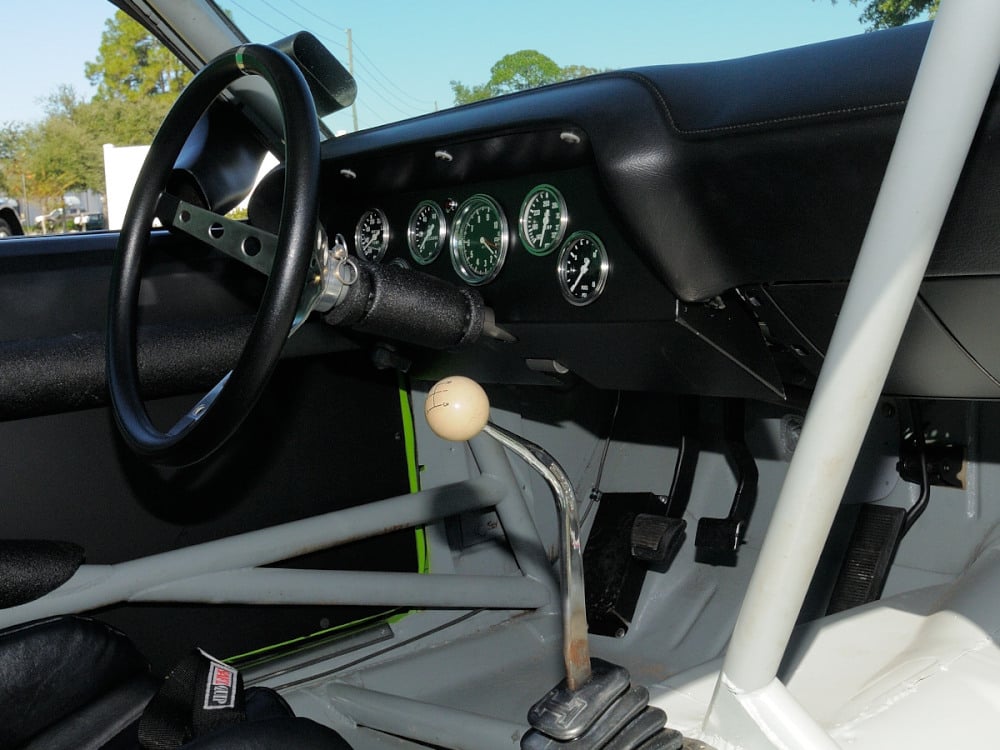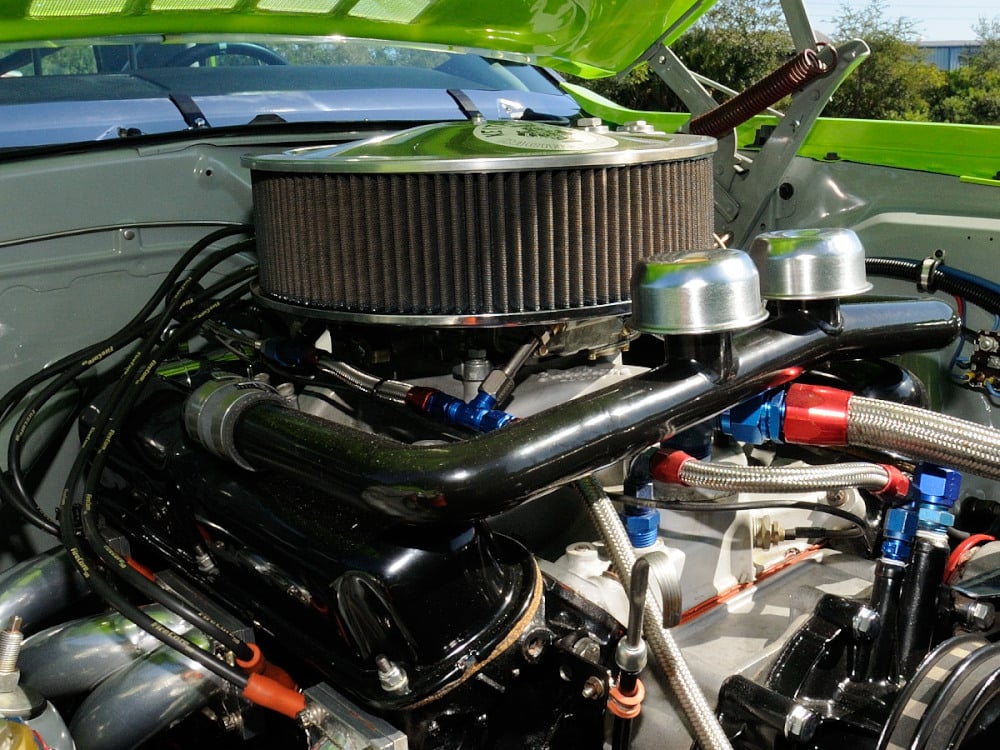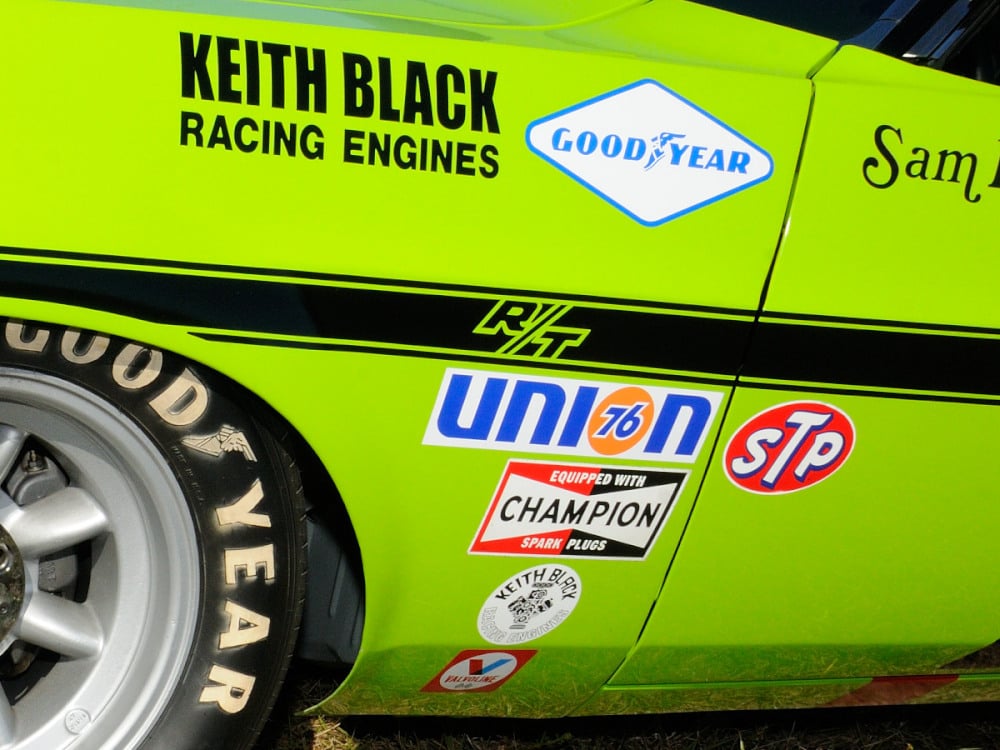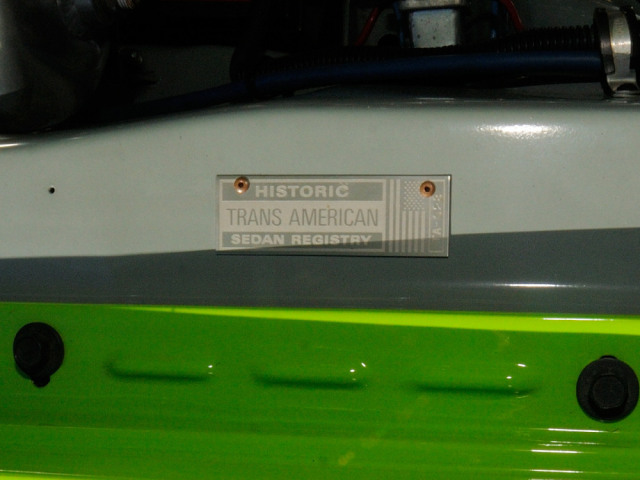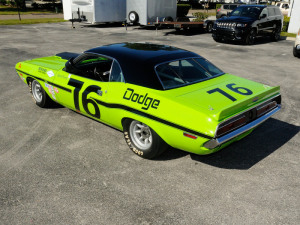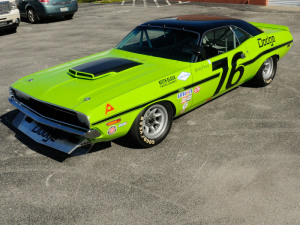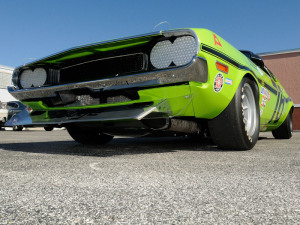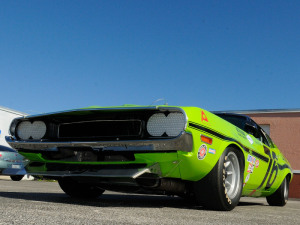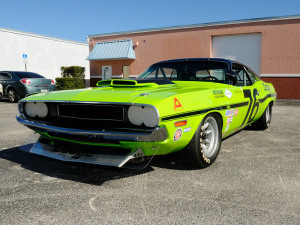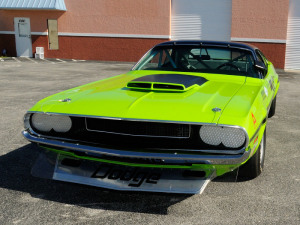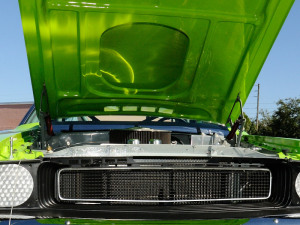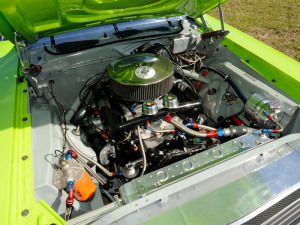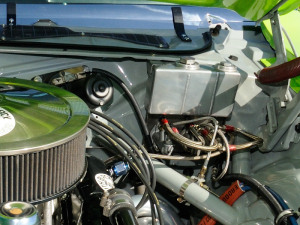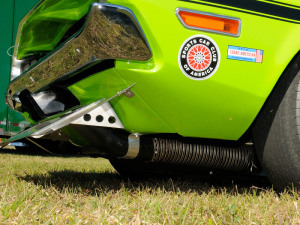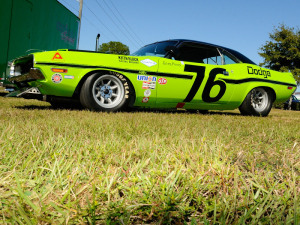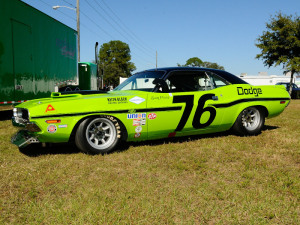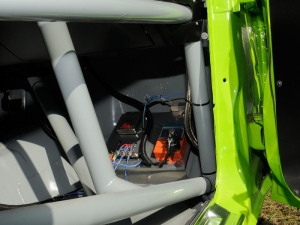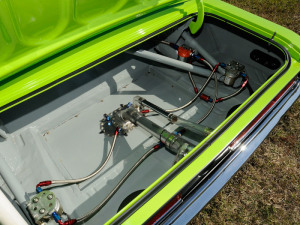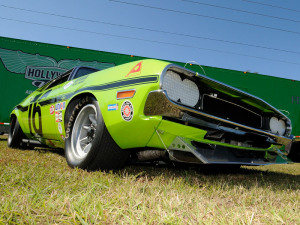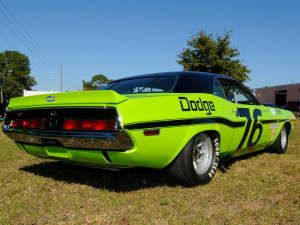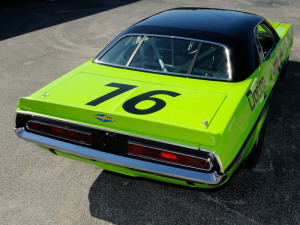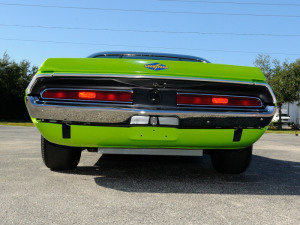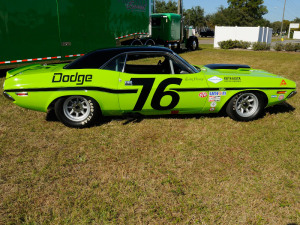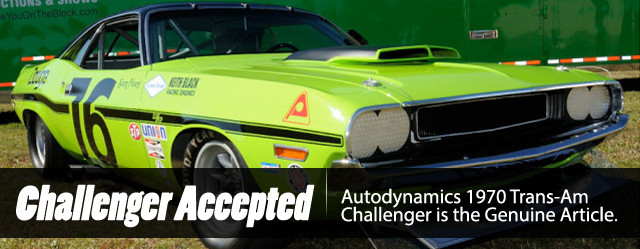
This beautiful Sublime Lime 1970 Dodge Challenger T/A is as real as it gets. This car has not just been restored; it has been resurrected from the scrap yard and returned to its former glory. This classic example of American road racing history is exactly the same as it was when it rolled out onto the grid at Lime Rock in the 1970s. The sight, the sound, the smell of the exhaust; nothing’s changed from the glory days of the Trans-Am series. This car is not like new, it’s the Genuine Article.
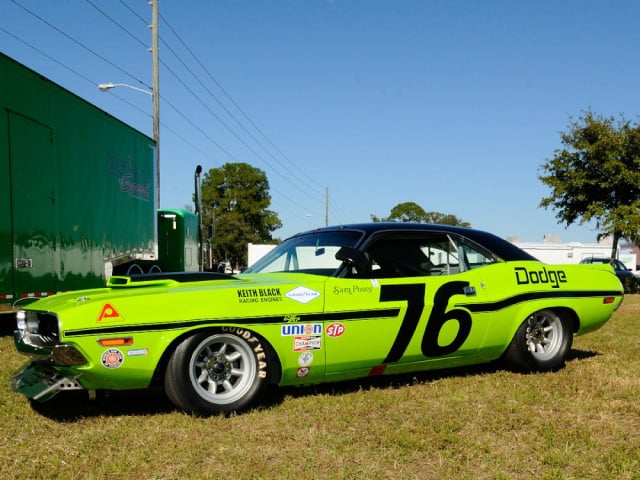
“Sublime Green” a color Sam Posey was not happy about, in this era a green race car was considered as bad luck.
First, a quick history lesson: the Trans-Am Series was originally formed in 1966 as the brain child of John Bishop, the presiding President of the SCCA. The series began its existence as the Trans-American Sedan Series during the onset of the “pony car” era. The cars were based on production unibodies with, what were essentially, stock suspension components. The series became known for the competition between the major manufacturers at the time, and spawned a number of high performance production vehicles, such as the Ford Mustang and the Chevrolet Camaro. Just about every manufacturer was represented in this series, American Motors campaigned the Javelin, Pontiac rolled out their ever popular Firebird, Mercury entered the field with the Cougar, and Chrysler was well represented with the Plymouth Barracuda, and the Dodge Challenger.
During this particular time frame, the factories were fully committed to their efforts within the series, and this was where the cliché saying of “win on Sunday, sell on Monday” originated. There was no secret to this type of marketing. If your race car finished ahead of the other manufacturers, you could rest assured your sales would increase over the competition. With this result-oriented system the pressure on the teams and drivers was constant, poor finishes could result in the loss of the factory dollars and support.
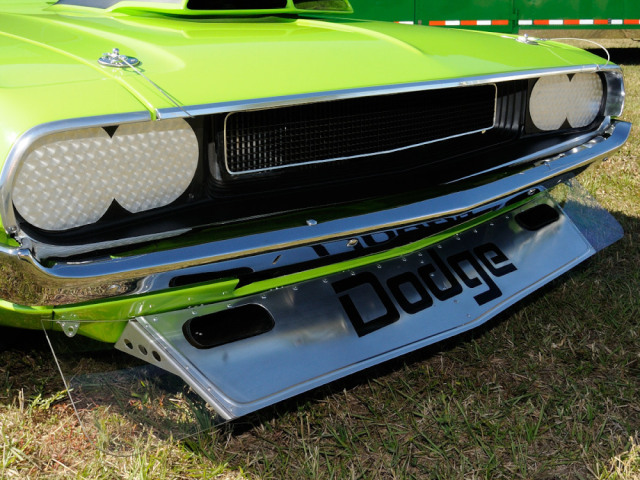
The aluminum and plexiglass front spoiler was cutting edge technology in its day, and was the precursor for the modern splitter used today.
With this in mind, the pressure to perform well spawned many rumors of, shall we say, creative thinking when it came to interpreting the rule book. Bodies that were dipped in acid to reduce overall weight, engine components that were not exactly factory production, and cleverly concealed extra fuel tanks, fact or fiction? More on this later. In 1971, for a number of well documented reasons, the factories withdrew their support, and the golden age of Trans-Am racing came to a halt.
After the demise of the series, a lot of the race cars were repurposed as pavement racers by local Saturday night week-end warriors. Over the years, most of these cars did not survive the rigors of the local short track wars, and ended up destined for the scrap yard, or left to decompose in an over grown farmers field, somewhere in the Mid West.
Fortunately for this particular car, a father and son duo of avid Mopar fanatics, Ed Skanes and his son Bryan, tracked down the remnants of what they were pretty sure, was one of the original Autodynamics Trans-Am Challengers. Both Skanes had a pretty good idea of what they had discovered and this father and son duo had a reputation around their home town of Lexington, Kentucky as the unofficial expert authorities, on anything Mopar. It is not unusual to see a dozen or more Chrysler products on their property, all in different stages of restoration.
The elder Skanes had spent many hours following a people trail, if you will, to locate this particular race car. Knowing these race cars had no identifying serial numbers, this sometimes exhausting research is a necessary evil. Skanes lost track of how many phone calls were made chasing leads on the whereabouts of the car. Hundreds of letters and the examination of countless old photographs were also part of the identifying process. In the end, Skanes vast knowledge of these factory backed race cars was the determining factor in properly identifying what was described by son Bryan as, “a rusting chunk of metal” when his father finally located, and confirmed it was the car he was searching for.
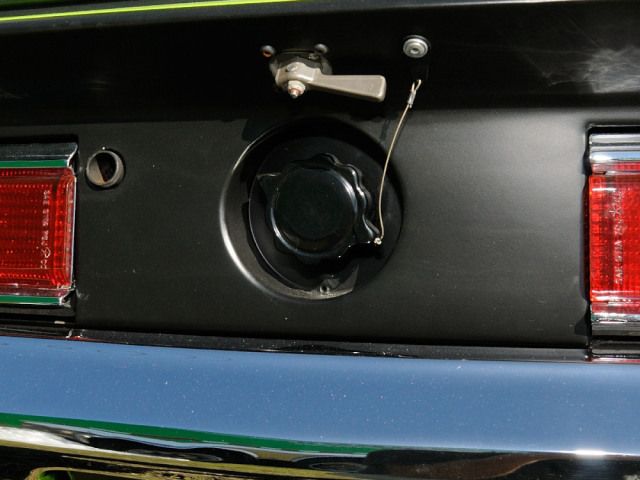
On a typical pit stop the gas man would have to unscrew the cap, using the lever above the gas cap, open the vent, fuel the car, close the vent, and put the cap back in place. Not exactly the fuel delivery systems we see today.
A large part of the knowledge Skanes had acquired on these cars, came as a direct result of his restoration of two other vintage Trans-Am cars; the number 48 Hot Wheels Barracuda and the sister car to this particular car, the number 77 Autodynamics Dodge Challenger. This experience with these cars, gave Mr. Skanes a working knowledge of just how these cars were designed and put together, and played a large part in properly identifying the number 76 car. The cars were originally developed and constructed in the shop of Dan Gurney’s All American Racers, and a number of small details in the chassis are very unique to all three cars. These details, although not totally revealed for this article, have to do with the positioning and angles of the bars in the cage, and what is referred to as a “very different cross bracing” under the dash area of the car. These details are as identifying as any serial number could be.
The interior is of a no frills design, driver comfort was provided by the air scoop on the windshiels pillar.
After returning home with the car, Skanes put the car on the side of his shop and covered it with a tarp. “We really weren’t sure just what we were going to do with it.” Bryan Skanes stated. “The car was really rough. Dad and I talked about how maybe we made a mistake with this one.” The car sat for a number of years untouched, and when the Skanes retired after a long career with Tenneco. He found he had more time on his hands than he knew what to do with, so, after a lengthy discussion with his son Bryan, the decision was made to start working on the Challenger.
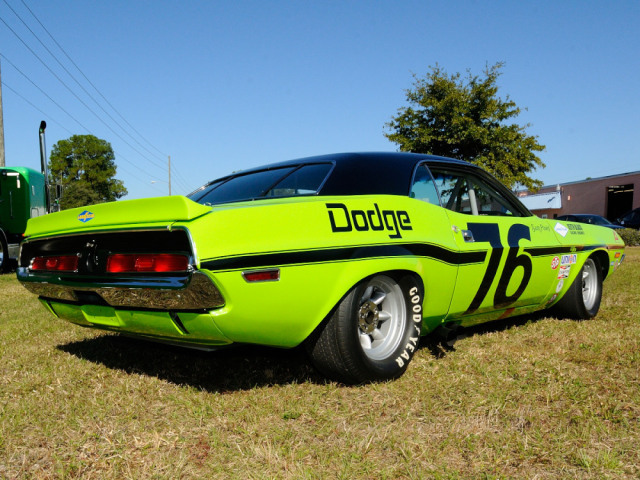
The small spoiler on the back proved to be somewhat lacking, and made these cars a handful to drive.
Skanes had something special in mind for this project. He didn’t want to just restore the car, he wanted to resurrect the car, to return it to its former glory. He wanted more than a car someone could go vintage racing with, he envisioned a prize winning show car. A car capable of winning best of show at any Concours d’Elegance it entered, a car that would properly represent the history, and the era, relevant to the glory days of Trans-Am racing.
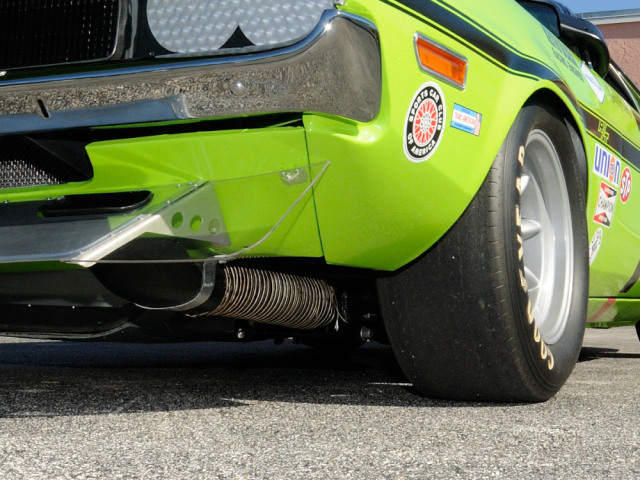
The 3″ ducting provides cooling for the massive 14″ Hurst Airmart rotors that supply the stopping power.
Over the years and during the restoration of the Gurney Barracuda, and the number 77 Challenger, Skanes had amassed enough original parts to complete the build on this latest project. All of these original parts were painstakingly refurbished before being used in the build. However, the original, 45-year-old rubber fuel lines, were all upgraded to modern braided lines. This of course, was done for obvious safety reasons. Everything else on this car is the original parts that was used on this car when it was transferred from the All American Racers shop, to the shop of Autodynamics in 1970. Brakes, bushings, torsion bars, shocks – even the shift knob – all original.
The Keith Black 303.8 cid motor is 100 percent original
The motor is an original Keith Black, destroked, 14 to 1 compression ratio, 303.8 cid Trans-Am race engine. The motor has been fully rebuilt with the original parts and is correct to the specifications for the 1970 Trans-Am race season. The power plant is coupled to a specially built, aluminum cased, four-speed transmission made to mimic the standard Chrysler a833 that was required by rule. Remember we spoke about creative interpretation of the rules earlier? This lightweight aluminum transmission was covered with a complex metallic coating to disguise the aluminum case, and fool the tech inspectors of the day.
The inspectors used a magnet mounted on a long stick to check the transmissions, if the magnet would stick; it was assumed the transmission was the Chrysler a833 and legal for the class, hence the metallic coating. The rear differential is an eight and three-quarter with a Detroit Locker, and uses gear ratios ranging from 3.90 to 4.30 depending on the track venue. The drivetrain, as mentioned above, is still in the car today. The car sits on the original magnesium, Mini- Light wheels wrapped with Goodyear Blue Streak rubber. The wheels still carry the Autodynamics etching on the back side of the wheel which was done to help identify the wheels and tires after a trip to the Goodyear trailer for new rubber.
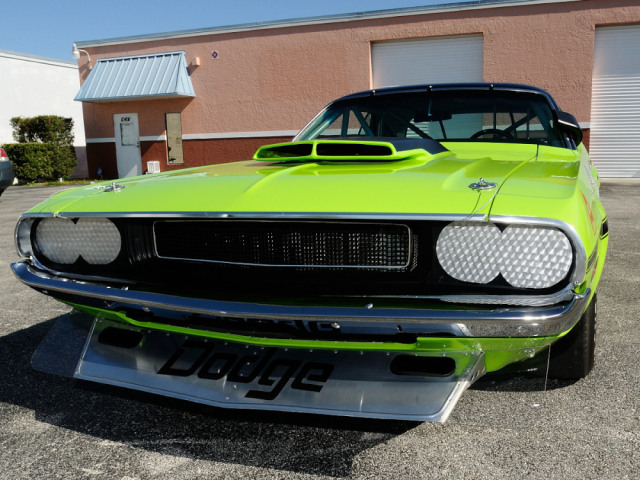
The car almost has a mean look to it, something a rival driver did not want to see in the rear view mirror.
After nearly ten years, the Skanes had finally finished the resurrection of this classic piece Trans-Am history, and what should be considered a true example of the ingenuity, and technologies of the era. Skane’s vision, was finally realized, the car received “Best of Show: Racing All Classes” at the 2009 Ault Park, Keenland, and Daytona Concours d Elegance. The car has also been given special recognition at the prestigious Amelia Island Concours d Elegance and was used by Chrysler as a featured display vehicle at the 2008 SEMA show in Las Vegas.
Sadly, Skanes has passed, and today the car is administered, and maintained by son Bryan, and longtime family friend, Chris Brown. Bryan and Chris are doing their best to extend the legacy of their beloved father and friend by continuing to locate, restore, and resurrect classic examples of Mopar racing history. With several projects currently in the works, the family has made the decision to make the number 76 Autodynamics Trans-Am Challenger available for sale, and have consigned the car to Hollywood Wheels Auctions and Shows for the Amelia Island Select. The car, along with all of the appropriate documentation and archival photos, will go across the auction block in March of 2015.The family is hopeful the car will go to someone that will appreciate the history of the car and realize the effort and dedication it took Skanes to resurrect this car from the impending scrap yard.
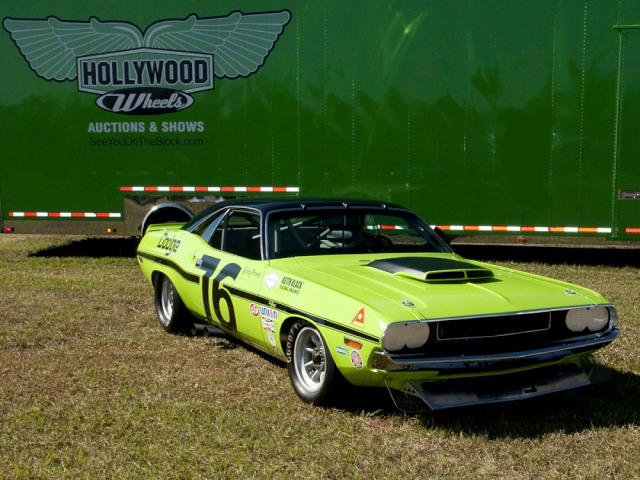
Hollywood Wheels Auctions and Shows will offer this piece of motorsports history at their Amelia Island Select Auction in March of 2015.
Although it is not certain who will buy the car, wouldn’t it be really cool if the owners of an automotive based museum, somewhere, anywhere, attended the auction in March, purchased the car, and put it on permanent display for all to see? You never know, let’s hope for the best.
For addition details and information on the sale visit www.ameliaislandselect.com



